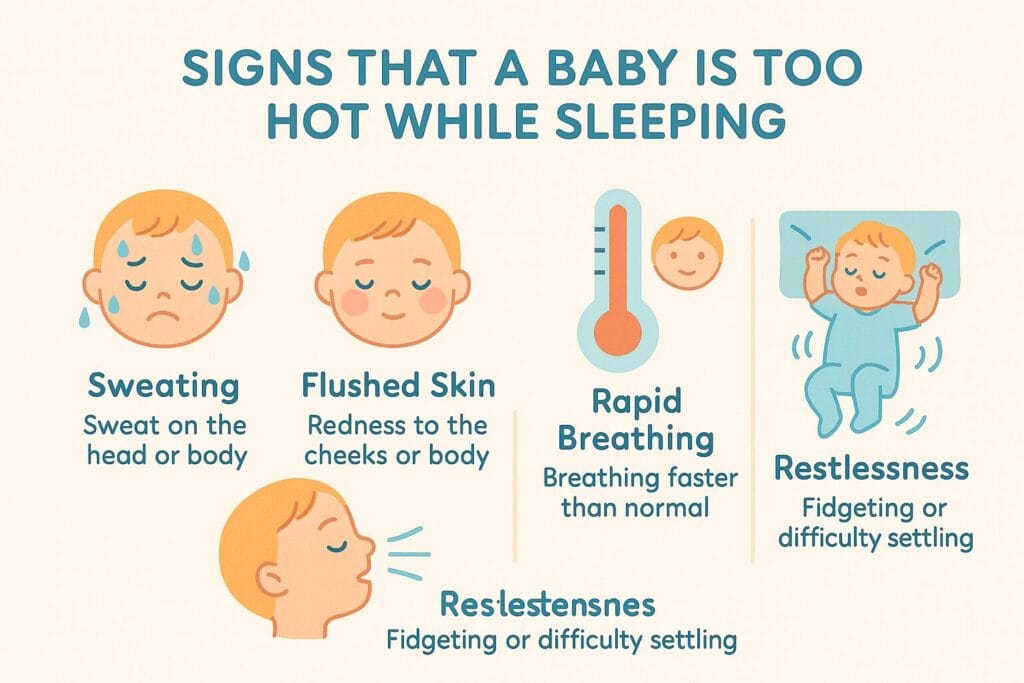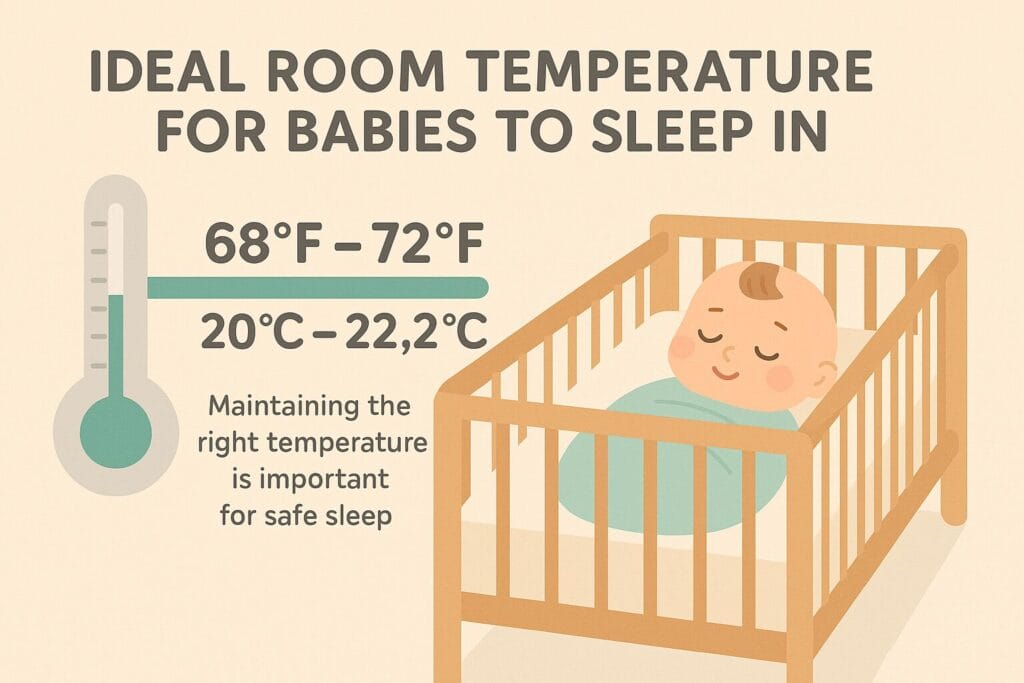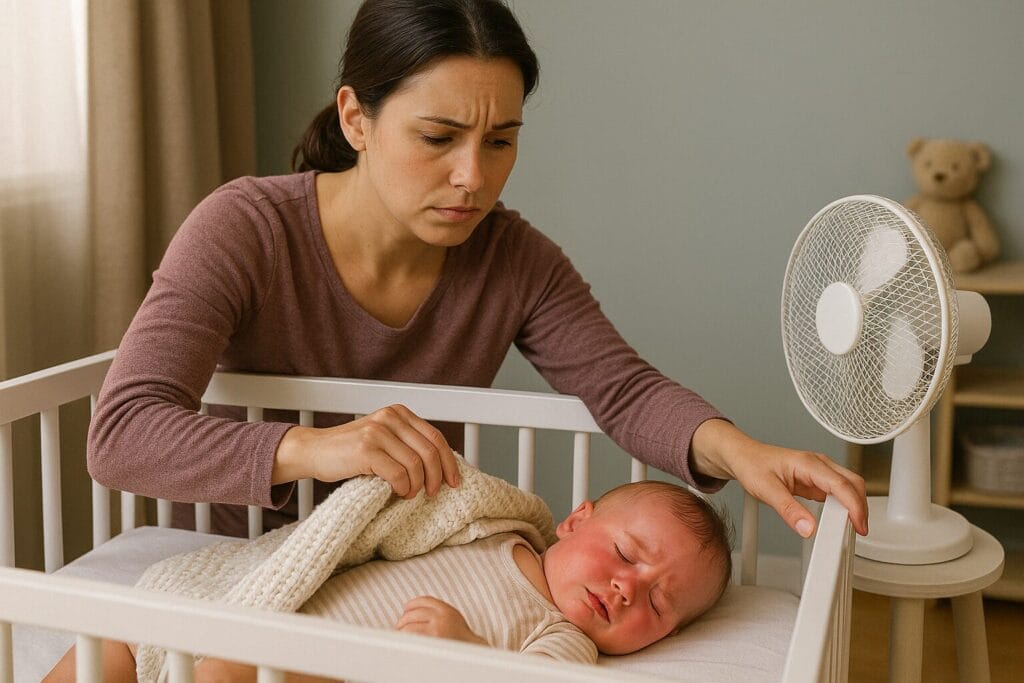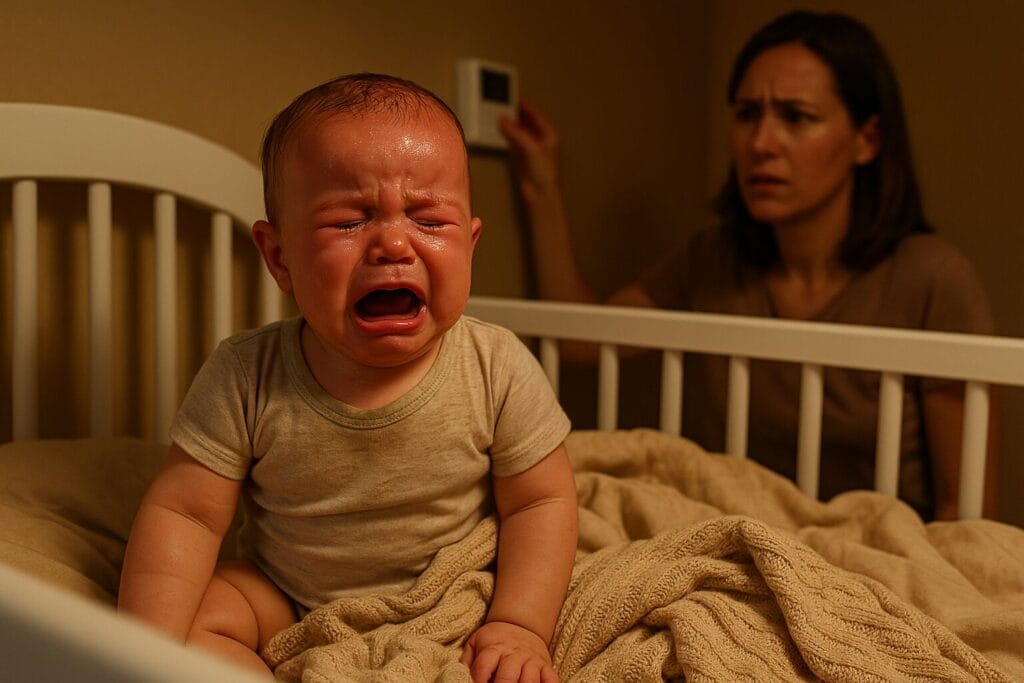As parents, ensuring your baby sleeps soundly and safely is a top priority. While you may carefully select the perfect crib, bedding, and sleepwear, one important aspect is often overlooked: the temperature. Signs baby is too hot while sleeping are often subtle but critical to recognize, as overheating can lead to discomfort and, in extreme cases, pose serious health risks to your baby.
This comprehensive guide delves deep into the signs baby is too hot while sleeping, why they occur, how to recognize them, and what steps you can take to prevent overheating. We’ll also discuss the potential dangers of overheating and provide helpful tips to maintain the perfect sleeping environment for your baby.
Table of Contents
Understanding Baby Temperature Regulation
Before diving into the signs baby is too hot while sleeping, it’s important to understand why temperature regulation in babies is more complex than in adults. Newborns and young babies have an immature thermoregulatory system. This means they can’t regulate their body temperature as effectively as adults. Babies rely on their caregivers to manage their sleeping environment and keep them comfortable.
Because babies lack the ability to adjust their body temperature, they are more vulnerable to overheating. Even minor changes in the room temperature or the way they are dressed can make a significant difference in their body temperature. Signs baby is too hot while sleeping are usually the body’s way of alerting you to the need for action.
What Causes Overheating in Babies?
Overheating in babies can happen for several reasons. It’s crucial to understand the underlying causes of overheating to prevent it from happening in the first place. The most common causes include:
1. Overdressing
One of the most frequent causes of overheating is overdressing your baby. While it’s natural to want to keep your baby warm, too many layers of clothing, including hats, blankets, or sleep sacks, can trap excess heat, making your baby too warm. Babies should not be dressed in more layers than you would typically wear in the same environment.
2. Warm Room Temperature
The room temperature plays a significant role in your baby’s comfort. Signs baby is too hot while sleeping are often caused by a room that’s too warm. Babies can quickly become overheated if their room is not kept within the recommended temperature range of 68°F-72°F (20°C-22.2°C). When the room temperature exceeds this range, reducing the heat is crucial.
3. Poor Ventilation
A lack of airflow or ventilation in the room can exacerbate the issue of overheating. Stuffy air in the nursery can make it difficult for your baby’s body to cool down, even if the room temperature is appropriate. Air circulation is key to maintaining a comfortable sleep environment.
4. Heavy Bedding
Heavy quilts, blankets, or non-breathable fabrics can cause your baby to overheat while sleeping. Signs baby is too hot while sleeping can emerge when babies are swaddled in thick blankets or tucked under multiple layers of bedding. Opting for lighter, breathable fabrics like cotton or muslin can help mitigate this risk.
5. Exposure to Direct Sunlight
Placing your baby’s crib in direct sunlight can cause the room to heat up quickly, leading to overheating. While sunlight may feel comfortable, it can elevate the room temperature, making it uncomfortable and unsafe for your baby.
What Are the Signs Baby is Too Hot While Sleeping?

Recognizing the signs baby is too hot while sleeping is essential for ensuring your baby’s comfort and safety. Babies cannot tell you when they’re feeling overheated, making it crucial for parents to stay vigilant and monitor their little one’s condition. Overheating can lead to discomfort and, in extreme cases, increase the risk of heatstroke or sudden infant death syndrome (SIDS). Here are some of the key signs baby is too hot while sleeping that you should look out for:
1. Sweating: A Clear Sign of Overheating
One of the most noticeable signs baby is too hot while sleeping is sweating. Unlike adults, babies don’t sweat in mild conditions. If you notice that your baby’s neck, back, or forehead is damp with sweat, it’s a strong indicator that their body temperature is rising. Sweating is the body’s natural response to try and cool down, but it often isn’t enough when the surrounding environment is too warm.
- Where to check: The back of the neck or forehead is where sweat is most commonly seen. Pay close attention to these areas when you check on your baby during sleep.
- What to do: If your baby is sweating, remove excess layers of clothing, adjust the room temperature, or reposition them in a cooler area to help them cool down.
2. Flushed Skin: Reddened Face and Neck
Another common sign baby is too hot while sleeping is flushed skin, particularly on their face, neck, or chest. When babies are overheated, the blood vessels in the skin dilate, which causes the skin to appear red or pinkish. This is the body’s attempt to regulate temperature by increasing blood flow to the skin’s surface, where heat can escape more easily.
- What to look for: Pay attention to your baby’s cheeks, forehead, and neck. If these areas look unusually red or flushed, this may be an indication that your baby is too warm.
- What to do: If you notice flushed skin, remove any unnecessary clothing layers and use a fan or cooler environment to help bring your baby’s temperature back down.
3. Warm to the Touch: Uncomfortable Heat
If your baby feels unusually warm to the touch, especially on their tummy, back, or neck, it could be another clear sign baby is too hot while sleeping. Babies’ skin tends to be soft and sensitive, so their temperature can rise quickly if they are too bundled up or in a hot room.
- What to check: Feel your baby’s tummy or the back of their neck for warmth. These areas will give you an indication of whether your baby’s internal body temperature is rising too high.
- What to do: If your baby feels too warm, consider removing a blanket or changing their clothing to something lighter. Make sure your baby is in a comfortable temperature range for sleep, ideally between 68°F and 72°F (20°C and 22°C).
“Wondering if your baby sleeps more when sick? Discover 5 surprising reasons and expert tips to help comfort your baby during illness.” Read more here.
4. Restlessness and Frequent Waking
Overheating can cause significant discomfort, which may lead to your baby becoming restless. One of the signs baby is too hot while sleeping is frequent waking during naps or nighttime sleep. Babies who are too hot might toss and turn, fidget, or have trouble staying asleep.
- What to observe: If your baby is waking up more often than usual, or if they seem restless and unable to fall back asleep easily, it could be a sign of discomfort from overheating.
- What to do: To help soothe your baby, remove excess layers and ensure the room temperature is cooler. You may also want to check that your baby is positioned comfortably and adjust the bedding as needed.
5. Increased Fussiness or Crying
Crying and fussiness are common responses to discomfort, and overheating can cause both. If your baby is more fussy or irritable than usual, especially if they are hard to calm down, it could be a sign baby is too hot while sleeping. This discomfort may manifest as crying, especially if your baby is overheated while trying to sleep.
- What to watch for: If your baby’s fussiness is paired with other symptoms like sweating or flushed skin, overheating is likely the cause.
- What to do: Offer comfort by calming your baby with gentle rocking or cuddles. Once the room is cooler and layers are reduced, your baby may settle more easily.
“If your newborn is fussy at night but calm during the day, discover 5 key reasons and effective soothing solutions to help them sleep better.” Read the full article here.
6. Rapid Breathing: A Response to Heat
Another sign baby is too hot while sleeping is rapid or shallow breathing. When the body is overheating, the natural response is to increase the breath rate to help regulate temperature. If your baby is breathing faster than usual or seems to be struggling with their breath, overheating may be the issue.
- What to observe: If your baby’s breathing becomes noticeably faster or more shallow, it’s time to check their temperature and ensure the room is cool enough for sleep.
- What to do: If your baby is showing signs of rapid breathing, adjust the room’s temperature, remove extra layers, and ensure your baby has access to plenty of fresh air.
7. Damp Diapers: Excessive Sweating
Overheating can also cause your baby to sweat more than usual, even around areas that aren’t directly exposed to heat, such as their diaper area. If you notice your baby’s diaper is unusually wet, it could be a sign baby is too hot while sleeping. This is especially true if you’ve already ruled out a full diaper or other causes for wetness.
What to do: Change your baby’s diaper regularly, and adjust their sleepwear to lighter, more breathable fabrics. If they are excessively sweating, it may also help to turn down the room temperature.
What to check: Feel your baby’s diaper area, especially if it seems damp. Check their back, neck, or forehead for signs of sweating to help identify overheating.
What to Do if Your Baby is Too Hot While Sleeping
Now that you know the signs baby is too hot while sleeping, it’s important to take steps to prevent overheating in the first place. Overheating is a significant risk factor for discomfort and even serious health issues in babies. Preventing overheating can ensure your baby sleeps safely and comfortably. Here are several strategies to help you manage your baby’s sleep environment and prevent overheating:
1. Dress Your Baby According to the Room Temperature

One of the most effective ways to prevent overheating and avoid the signs baby is too hot while sleeping is to dress your baby appropriately for the room temperature. Babies can easily become too warm if they are dressed in layers that are too heavy for the environment. Instead of overdressing your baby, use lightweight and breathable fabrics that allow their skin to breathe and regulate their temperature more easily.
- What to do: Opt for a light cotton onesie or a cotton sleep sack, which provides comfort without trapping excess heat. These fabrics allow air to circulate around your baby’s body, helping them stay at a safe and comfortable temperature.
- What to avoid: Avoid heavy fabrics, such as fleece, unless it’s particularly cold. Layers of thick clothing or blankets can quickly cause your baby to overheat, making them more susceptible to the signs baby is too hot while sleeping, like sweating or flushed skin.
2. Keep the Room Temperature Between 68°F and 72°F (20°C – 22.2°C)

Maintaining a stable room temperature is essential in preventing overheating, and it directly influences whether your baby will exhibit signs baby is too hot while sleeping. The optimal room temperature for babies is between 68°F and 72°F (20°C – 22.2°C). A room that’s too hot can lead to excessive sweating, rapid breathing, and flushed skin, while a room that’s too cold can make your baby uncomfortable and restless.
- What to do: Use a room thermometer to keep track of the room’s temperature. If it gets too warm, consider using a fan or adjusting the thermostat to lower the temperature.
- What to avoid: Be cautious about overheating the room with space heaters or other heat sources, especially when babies are asleep. These can cause the room temperature to exceed the ideal range and increase the likelihood of your baby experiencing signs baby is too hot while sleeping.
3. Use Lightweight, Breathable Bedding
Another way to avoid the signs baby is too hot while sleeping is by using lightweight, breathable bedding. Heavy blankets, quilts, or comforters can trap heat and contribute to overheating. Instead, opt for bedding made of natural, breathable fabrics like cotton. These materials will allow your baby’s body to maintain a consistent temperature while they sleep, reducing the risk of overheating.
- What to do: Choose cotton sheets or a lightweight sleep sack for your baby. These options will keep your baby warm without causing them to overheat. Sleep sacks are also safer than loose blankets, as they prevent the baby from becoming tangled.
- What to avoid: Avoid thick, heavy quilts or comforters that can cause your baby to sweat excessively. They can also block airflow, increasing the risk of signs baby is too hot while sleeping, such as rapid breathing or flushed skin.
4. Ensure Good Ventilation

Proper ventilation is an often-overlooked but essential factor in preventing overheating. A poorly ventilated room can cause heat to build up, which could lead to signs baby is too hot while sleeping, such as sweating or restlessness. Ensuring good airflow helps maintain a comfortable environment for your baby to sleep in.
- What to do: Open a window or use a fan to promote air circulation in your baby’s room. Fresh air can help regulate the room’s temperature and prevent it from becoming too warm, reducing the likelihood of overheating.
- What to avoid: While a fan can be helpful, make sure it’s not blowing directly on your baby. It’s important to keep the airflow indirect, as a fan pointed directly at the baby could cause discomfort or even lead to colds if the air is too cold or dry.
5. Avoid Direct Sunlight

Direct sunlight can rapidly increase the temperature of a room, especially if the room has large windows. If your baby’s crib is positioned in direct sunlight, this can cause the temperature to rise beyond a comfortable level, resulting in the signs baby is too hot while sleeping. Babies are particularly sensitive to sunlight and can quickly become overheated without warning.
What to avoid: Avoid placing your baby’s sleeping area in direct sunlight, especially during the hottest parts of the day. Even a short period of direct sunlight can cause the room to heat up, leading to overheating and the signs baby is too hot while sleeping, such as flushed skin or sweating.
What to do: Position your baby’s crib or bassinet away from windows that receive direct sunlight. During the day, use curtains or blinds to block out the sun and keep the room temperature consistent.
When to Seek Medical Help

If you notice any of the following signs baby is too hot while sleeping, it’s important to seek medical help immediately:
Excessive Sweating
If your baby is sweating heavily, especially on their neck, back, or forehead, and it’s not due to normal room temperature, it could signal overheating. Persistent sweating requires professional advice.
Rapid Breathing or Difficulty Breathing
If your baby is breathing rapidly or struggling to breathe, especially with chest movements or flaring nostrils, this is a concerning sign baby is too hot while sleeping and requires immediate attention.
Unresponsiveness or Lethargy
If your baby is unusually drowsy, hard to wake, or unresponsive, it may indicate severe overheating. This needs urgent medical attention.
Severe Irritability or Crying
Excessive crying and irritability, coupled with other signs like flushed skin or sweating, can be signs of overheating. If calming methods don’t work, seek medical help.
If your baby shows any of these signs, it’s better to be cautious and consult a healthcare provider. Overheating can be dangerous, and quick action is crucial for your baby’s safety.
FAQs: Signs Baby is Too Hot While Sleeping
1. How can I tell if my baby is too hot while sleeping? Sweating, flushed skin, rapid breathing, and warm skin are clear indicators of overheating.
2. What is the ideal room temperature for my baby to sleep in? The ideal temperature is between 68°F and 72°F (20°C to 22.2°C).
3. Is covering my baby’s stroller with a blanket during hot weather safe? Covering the stroller with a blanket can trap heat and increase the risk of overheating.
4. How should I dress my baby for sleep in warmer temperatures? Dress your baby in lightweight, breathable fabrics like cotton, and avoid heavy blankets.
5. Can a baby overheat even in cold weather? Yes, overdressing your baby or using heavy blankets can cause overheating.
6. What should I do if I suspect my baby is too hot during sleep? Remove a layer of clothing, adjust the room temperature, and offer fluids if appropriate.
7. Are there specific signs that indicate my baby is too hot? Signs include sweating, flushed skin, rapid breathing, and damp diapers.
8. How can I prevent my baby from overheating during sleep? Dress your baby appropriately, maintain a comfortable room temperature, and use lightweight bedding.
9. Is using a fan in my baby’s room safe to keep them cool? Yes, using a fan for circulation can help keep the room temperature comfortable.
10. When should I seek medical attention if I suspect my baby is overheated? Seek help if your baby is unresponsive, breathing rapidly, or excessively sweaty.
Conclusion
Recognizing the signs baby is too hot while sleeping and knowing how to prevent overheating is essential for your baby’s health and comfort. Maintaining an ideal room temperature, dressing your baby appropriately, and monitoring their comfort can prevent overheating and ensure a safe sleep environment. If you notice any signs of overheating, taking prompt action can prevent discomfort and help your baby sleep more soundly. Overheating is a concern that every parent should take seriously, but with the right precautions, you can create a safe and comfortable space for your baby to rest.



